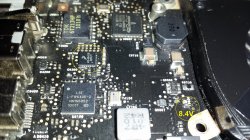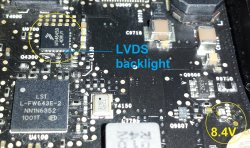I like that logic. As bad as the 3rd, 4th and 5th pins were destroyed on the cable, it makes sense that there might be something going on inside the connector on the board that i can't see. I'll try switching it out and see what happens. Thanks for the valuable input.
It's likely a short in the LVDS cable. I've had this happen before
It might also be a bent pin on the inside of the LDVS logic-side connector, if you have a microscope or good magnification it would be worth a look at that.




![url]](/proxy.php?image=http%3A%2F%2F%5Burl%3Dhttp%3A%2F%2Fpostimg.org%2Fimage%2Flbshb3hcl%2Ffull%2F%5D%5Burl%3Dhttp%3A%2F%2Fs26.postimg.org%2Fkz134wz2x%2F20140709_094236.jpg%5DImage%5B%2Furl%5D%5B%2Furl%5D&hash=67d16f541424de1f592e32a4c1d0ade8)
![url]](/proxy.php?image=http%3A%2F%2F%5Burl%3Dhttp%3A%2F%2Fpostimg.org%2Fimage%2Fo75khylcl%2Ffull%2F%5D%5Burl%3Dhttp%3A%2F%2Fs26.postimg.org%2Ffow4dmeu1%2F20140709_094259.jpg%5DImage%5B%2Furl%5D%5B%2Furl%5D&hash=5db6945fcf07747057cf1420087906bd)

